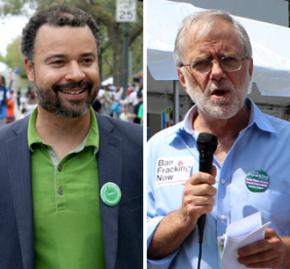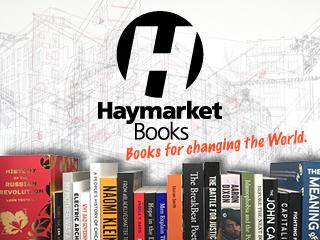This campaign doesn’t end on Election Day
In a mostly dismal election year, Howie Hawkins and Brian Jones gave the left something to cheer about with their Green Party campaign for the governor and lieutenant governor of New York. By getting almost 5 percent and 200,000 votes, Hawkins-Jones had the most successful independent left-wing campaign in New York state in more than 50 years.
The Hawkins-Jones campaign was able to bring attention to struggles to defend public education and ban hydrofracking--and to show that it's possible for the left to begin building organization outside the Democratic Party. Howie and Brian spoke to about their assessment of the campaign and their thoughts about next steps.
WHAT WERE your hopes for the campaign and were they realized?
Howie: We wrote four goals into our original campaign plan last January. I'll run through them:
1. At least 50,000 votes to retain our line on all New York ballots for the next four years. We easily achieved this goal.
2. 5 percent and 250,000 votes to change New York politics by establishing a viable independent left party. We chose this goal as being within our reach if we ran a very good campaign. The numbers would basically equal the best showings for independent left gubernatorial candidates in New York history--5.7 percent and 5.6 percent for Socialists in 1918 and 1920; 220,000 votes for the independent American Labor Party candidate for governor in 1950.
We got 4.9 percent and nearly 200,000 votes when all the paper ballots are counted. That's close enough for what we hoped to achieve with this vote: Making the Greens the voice of the left--or at least the independent left--in New York politics in the media's and the public's eyes, displacing liberal Democrats and their second ballot line, the Working Families Party.

When we were polling consistently in the 6 percent to 9 percent range statewide from July through late October, we began to hope we could break double digits. I think we came up short of what the polls indicated due to last-minute lesser-evil voting and the record low turnout.
It remains to be seen how the media and public will regard our new status. Some pundits gave us due respect. Politico's Capital New York said the Greens were the "the big third-party winners" and Time Warner Cable's Capital Tonight said "the Green Party has achieved a new level of permanency in state politics." Our ultimate standing will depend on our organizing and media work going forward.
3. Move the debate on key issues. It remains to be seen how much we moved the debate. After our 2010 campaign, our "Ban Fracking" demand was picked up by the whole anti-fracking movement--which before our campaign had mostly been demanding a moratorium while it was studied.
We got a lot of media coverage for several of our platform planks this time: full and equitable school funding, opt out of high-stakes testing, a $15 minimum wage, ban fracking, 100 percent clean energy by 2030, single-payer health care, full public campaign financing. How much we are able to move the debate on these demands depends on our follow-up organizing and media work. Our significant vote gives us the opportunity to do that.
Because Cuomo will use the Republican-majority state Senate as a shield against progressive reforms for the next two-year legislative session, our organizing will be more about movement building around these issues than passing legislation. [Editor's note: After this roundtable took place, the New York Post reported that Cuomo had made a secret deal that left the Republican majority in the state Senate intact.]
But we will be demanding legislative votes on these issues to put the incumbents on the record, which will set up our campaigns for the 2016 state legislative elections.
4. Increase Party Membership and Strengthen Party Organization. The campaign raised new interest in the Green Party. We have many requests for support in organizing new county and local Green organizations across the state. Our original campaign plan included keeping some staff on for a couple months after the campaign to help with following through on organizing. That's what we are doing now after the election.
Brian: For my part, I was hoping especially to give an electoral expression to the movement to defend and improve public education. Teachers, parents and students have been organizing against school closures, charter school co-locations, high-stakes standardized testing and union-busting.
The people most directly involved in this organizing increasingly found themselves up against high-level Democratic Party officials--including the U.S. Department of Education and the White House. In my view, the sooner that parents, teachers and students begin seeing themselves as building a movement that is self-consciously independent of the Democratic Party, the harder it will be for the Dems to co-opt and derail our movement.
In this regard, I think our campaign made important strides forward. The first people I went to for support were education activists statewide, and they all responded enthusiastically. Many were first-time Green voters, but their experience told them that challenging corporate education reform requires being willing to challenge Democrats.
The six unions that endorsed us were all teacher unions. That doesn't meant that every member of those locals is now committed to independent politics, but it represents an important opening for that discussion. Perhaps the best-known public school advocate in the country, Diane Ravitch, endorsed our campaign. For the unions and for Ravitch, this was their first time voting Green.
HOWIE'S VOTE increased dramatically from his last run in 2010--particularly in New York City. What do you think accounts for that?
Brian: The terrain was very favorable for making an advance. Cuomo is widely despised, but is propped up by the astronomical wealth of his core supporters and, of course, the Democratic Party machine. The New York Times spent the summer exposing him as thoroughly corrupt, and in the Democratic Party primary, he faced a progressive challenger who gave liberals confidence that he could and should be challenged.
Then there's the fact that "left" groups like the Working Families Party (WFP), which endorsed Cuomo claiming they would push him to the left, were quickly embarrassed by the fact that Cuomo pledged--immediately after securing the nomination--not to keep his promises to them. He even created another ballot line in order to undermine the WFP.
Lastly, but not least by any means, the issue of education was paramount. The very issue for which Cuomo was widely hated among progressives--his determination to promote privatization through high-stakes standardized testing, charter schools, and union-busting--was the very issue where we've seen some intensive grassroots organizing in this state.
The internal dynamics of the umbrella teachers union for the state--New York State United Teachers--also played a role. Teachers statewide moved toward open revolt against a leadership that has been loyal to the privatizer-in-chief Cuomo. Many union presidents and teacher activists around the state challenged the leadership in the statewide union elections, and then they banded together again to support Cuomo's challenger in the Democratic primary.
When AFT President Randi Weingarten intervened in the primary to support Cuomo, recording a robo-call for him, it was the straw that broke the proverbial camel's back. A self-conscious group of teacher union activists statewide had already cohered before our campaign, and supporting us was a logical next step. With connections to union members and school communities statewide, these activists added considerable human resources to the campaign.
Howie: Cuomo's conservative policies, particularly his attacks on public schools, teachers and state workers, generated a protest vote from liberal Democrats. Our polling in the 6 percent to 9 percent range enabled us to get more media coverage in New York City media, which ignored us in 2010.
ANDREW CUOMO has seemed to go out of his way to antagonize liberals. How much do you think the Green Party vote was the result of people's dislike of one odious candidate, and how much do you think it represents a growing questioning of the Democratic Party that independents can build on for future elections?
Howie: I think it's about half and half. I take our 2.5 percent vote for Theresa Portelli for comptroller and 2 percent for Ramon Jimenez for attorney general to represent the vote of the independent left. The other half of our 5 percent was protest votes by progressive Democrats.
Voter abstention by working class voters was 80 percent. The Democrats have lost them. They are now disgusted by and alienated from the whole political process. The independent left will grow by organizing with these voters.
Brian: Certainly, some of our voters and supporters this time around were with us for this election only. But their support had the effect of enhancing the legitimacy of independent campaigns. There are a lot of good people out there who are holding out hope that progressives will be able to capture the Democratic Party.
In my experience, the people most directly involved in grassroots organizing are the most open to shifting on this question, because if you really go out and try to change something--anything--you eventually start stepping on Democratic Party toes. There is a group of people who are changing their minds about the Democratic Party through bitter experience.
It's hard to move from something to nothing, though, so independent campaigns--especially if they are perceived to be successful--play a role in helping people cross over.
HOW WAS the campaign able to connect with grassroots activism?
Brian: Everywhere I went, I was set up to speak alongside local activists. This way, the campaign attempted to amplify their voices, not just our own. I spoke alongside parents, teachers, students, former prisoners, people fighting for LGBTQ rights, for immigrant rights and more.
As you might imagine, these events generally reflected the strengths and weaknesses of the state of grassroots organizing in various places. Even if some of the events we held were more modest than we hoped, I'm proud that we stuck to our guns and tried to make these connections, even if we were only planting seeds for future growth.
Howie: We were able to connect with the movements to defend public education and ban fracking, the two movements with the most energy in New York these days. A half dozen teachers union locals and several public education advocacy groups endorsed us. We also strengthened ties with activists working for a fracking ban, clean energy, single-payer health care, a $15 an hour minimum wage and criminal justice reform.
WHAT WAS the most interesting or surprising thing you learned over the course of the campaign?
Howie: The most surprising thing was the endorsement of six liberal Democratic clubs in Manhattan and Brooklyn. They've never endorsed outside the Democrats before. These clubs represent issue activists, not Democratic hacks.
It was a protest vote for them, not a break with the Democrats. But it set a good precedent that I hope we can build on by establish ongoing relationships to work together for progressive reforms between elections. The Greens can be the alternative for them in future elections as the neoliberal policies of financial, real estate and other big corporate funders continue to prevail at the top of the Democratic Party.
Brian: I was surprised by how much time we needed to spend fundraising on the phone. It turns out that the very best way to get money is to ask for it. Without full public financing of campaigns, this kind of intense fundraising is going to be a serious part of electoral campaigns--including independent ones.
People were incredibly generous, especially given the tough economic times we're facing. Our donors are from the 99 Percent--they're suffering under the weight of credit card debt, medical debt, student loan debt and insufficient wages. Still, they dug deep and came through.
Even in the age of Facebook, there's value in getting potential supporters and activists on the phone. Whether or not you're asking for money, actual human interaction is essential to organizing. As much as it isn't fun to make hours and hours of phone calls, I was pleasantly surprised by the actual experience of having those conversations.
HOW DO you think the campaign's success can benefit labor and social movement struggles beyond the ballot box?
Howie: The Greens will have to work with labor and social movements to fight for reforms between elections. The Green Party gives labor and social movements leverage in these struggles because we're the alternative in the next election.
The Democrats won't be able to take labor and the movements for granted. But caught between their elite funders and grassroots voters, the Democrats won't be able to deliver consistently. By remaining consistent allies in these fights, the independent Green option in elections will become a more viable alternative for labor and social movements.
Brian: The more our unions and social movements operate from the position of independence from the Democrats, the stronger they will be. The Democratic Party takes labor for granted--"lesser evilism" is really about lowering our expectations. Lowered expectations are death to social movements, which is part of why the Dems are so lethal to real movements for change.
When we support independent candidates, we can speak with our voices, articulate our own demands and actually raise expectations. That's one of the ways that what we do at the ballot box serves labor and social movements.
HOW CAN the Green Party build on this year's electoral success? What challenges will it face to realize that potential?
Brian: The next steps are exciting, but by no means straightforward.
The Green Party has an opportunity to develop its base of activists statewide. How much that's about other electoral campaigns and how much that's about grassroots activism will have to be sorted out. The electoral process is demanding, and it's rigged against independents. But it gives us a megaphone and platform to access people who normally don't hear from us.
Sinking roots in diverse communities is also a tremendous challenge. I'm proud of the strong stances our campaign took on issues of institutional racism and oppression, but turning broad support into active support and overcoming divisions is no easy feat. The entire left is trying to figure this out, not just the Green Party.
Howie: The Greens will have to systematically build a mass membership party, funded by its members. That's the only way it can end the dependence and co-optation of progressive movements by the "nonprofit-industrial complex" around the Democratic Party funded by the super-rich corporate liberals and their foundations.
These NGOs are movement killers, because they water down demands to what Democratic leaders will accept and mobilize in a top-down fashion that disempowers and de-activates grassroots people. The Greens need to get good at organizing, not merely mobilizing. We need to respect and foster the dynamism of movements where regular people develop their own ideas, demands, actions and leaders.
The Greens will also have to get good at organizing across the lines of race, occupation and location. New York is the most segregated state in the nation by race and by class. Its income distribution is the most unequal of any state.
The working class is separated physically by significant distances, into urban, suburban, and rural locations with different racial and occupational profiles. It is divided by occupation between public-sector and private-sector workers, union workers and nonunion workers, and workers in the welfare and criminal justice systems who are supervised by public-sector workers.
The 1 Percent uses this segmentation to divide and rule. Finding a way to bring these sectors of the working class together around common interests and values is the biggest challenge to building a movement that can unite the working class majority and take power.


